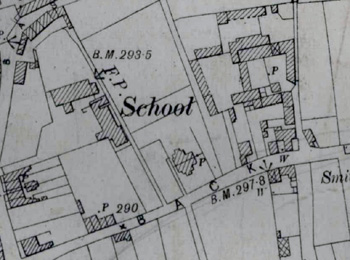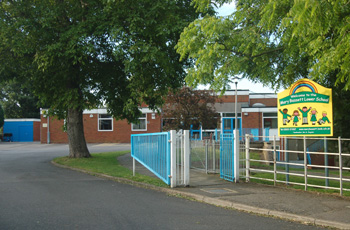Bassett Road Infants School Leighton Buzzard

Bassett Road schools in 1901
Directories state that Leighton Buzzard British Infants' School opened in 1830 in Bassett Road. Interestingly, in The Bedfordshire Schoolchild by David Bushby [Bedfordshire Historical Records Society Volume 67] is a note of an application on 12th October 1838 for a grant of £75 to help build a 450 place British School in Leighton Buzzard. This suggests that the 1830 date for the creation of the school is wrong and this is confirmed by the Bedfordshire Mercury which reported on the opening of the school on Monday 11th November 1839, on a site given by prominent Leighton Buzzard Quaker John Bassett: "A neat and commodious Infant School House, including a residence for the Teacher, has been erected at Leighton Buzzard, the expense of which, with the exception of a promised grant of £75 from the Government, was met by voluntary contributions. The property is vested in Trustees selected from the Society of Friends (a member of which originated it with a donation of £100), Episcopalians, and the Dissenters. The Institution was opened on Monday the 11th inst. under the direction of a committee equally free from any sectarian spirit. A competent Governess has been engaged from the Home and Colonial Infant School Society, who, with an assistant teacher, appears admirably qualified for the work of Infantile tuition. The friends of education at Leighton have now liberally provided for the scriptural instruction of the children of the poor, by means of the large Sunday School, Lancasterian and Church Day Schools, and last but not least in importance, the Infant School, which will not only prove highly beneficial to the moral interest of the rapidly increasing population and this rising town, but also, we hope, induce the leading families of many surrounding villages, to institute without delay a similar charity for the benefit of the poor and neglected Peasantry".
The Bedfordshire Schoolchild quotes two inspections of the school made in the 1840s: "Inspection of Leighton Buzzard British Infants School, 27 March 1846. Under an able female teacher, aided by a promising assistant to manage the "little ones"; the cheerfulness, order, and modest confidence prevailing among the children testify to the goodness of her discipline under the superintendence of a zealous ladies' committee. The instruction, as far as it goes, is good and many of the children will get none other but be taken at once to straw plaiting".
Report of Joseph Fletcher, 1848: "Leighton Buzzard, Infants. Roll 170, average attendance 130, present at examination 113, 26 July 1847. I inspected the infant school at Leighton Buzzard under very disadvantageous circumstances, the children being just reassembled from the summer holidays, and distracted by a great fair occupying the streets of the town, and preventing the attendance of most of the committees. This school, however, has been greatly improved by carrying out the recommendations made at my last visit; and it has steadily increased since that date in number and efficiency. The improvements were effected with the aid of a grant of £50 from their Lordships, which has been well and faithfully expended, and has rendered this almost a complete little institution, of all the greater value in the locality, where the wretched trade of straw-plaiting is a complete bar even to the existence, much more to the success, of girls' schools. The zealous and efficient committees of this school (ladies and gentlemen) are anxious to have a pupil-teacher under their very efficient mistress, one who shall be of superior capacities to her present assistant, who is nevertheless, above the average in qualifications. I had an express meeting with them on the subject, as also with the promoters of the British School for boys here, who have appointed to it a better master than it had when I was last here and are desirous to place it under inspection by express memorial to their Lordships. The operation of the new Minutes being explained to them, they appear very desirous also to avail themselves of the advantages offered by them".
The mistress mentioned is Fanny Elizabeth Pearce. Only two schools are mentioned in a directory of 1847, the British Boys' School in Beaudesert and an infants' school in Friday Street run by Miss Pearce. Interestingly, this latter is not called a British School. It should be noted that Friday Street, at that time, was the name given to the street which later became West Street (it was also called Back Lane!). The site of the British Schools in Bassett Road lay on the corner of Friday/West Street/Back Lane and Bassett Road.
In March 1893 a School Board was formed in Leighton Buzzard which took over the running of the British Schools, henceforth known as Board Schools. By this time there was need for a second infants' school in the town to augment the school in Bassett Road. It was decided to use the 1813 built British Boys' School premises for the infants which, after enlargement and alteration could accommodate 300. This school lay on the corner of Beaudesert and East Street.
The Education Act of 1902 abolished School Boards, replacing them with a Local Education Authority which, for Bedfordshire, was Bedfordshire County Council. Thus board schools became known as council schools. Bedfordshire & Luton Archives & Records Service has a scrapbook of cuttings of visits made to most Bedfordshire Schools by School Inspectors for a period from just before the First World War through the inter-war years [E/IN1/1].
The first inspection of the school in the volume came in 1913, when average attendance was 240. The inspector stated: "The School is in admirable order and doing well in all respects. The Head Mistress and her assistants work hard, the methods are thoroughly sound, and in spite of prolonged epidemic sickness and consequent closure, the children have been sent on to the schools for older scholars remarkably well prepared to take their place therein". The next report in the volume is not until ten years later, when average attendance had sunk to 89. It was reported: "It is pleasing to report that the Reading and Number have improved since the last inspection. It is true that the Drawing does not yet fully serve its purpose, but on the whole the School is in as satisfactory a condition as can be expected, considering that it has been short-staffed since the summer holidays".
A year later average attendance had fallen still lower, to 68. "Since the Head Mistress attended the course provided by the Authority for Infant Mistresses at Whitsuntide, several interesting developments and experiments have taken place in the School. The teachers have willingly given up a great deal of time to the preparation of apparatus for teaching Number and Reading, and the School has no doubt benefited…the School is a happy little place and it may be said generally that good work is being done". By 1924 average attendance was back up to 84: "The work of the Staff and the children in this School is very creditable. Reading is unusually good and the other subjects are carefully and successfully taught; the attention which is given to obtaining distinct articulation is most praiseworthy".
The next report dates to 1928: "The work in this Department continues to show much care and skill in the teaching, and the level attained by the children is highly satisfactory, in all subjects. The speech training and reading in particular deserve special notice, and the arithmetical training is very sound". The last report in the volume dates to 1931: "This department is well conducted and the work remains as satisfactory and progressive as in the past. Careful consideration is given to any methods whereby progress may be achieved and the result is seen in the readiness of the children to grasp new ideas. The work is well grounded in the elementary stages and the recreative side of the school life is skilfully managed".
The school closed on 1st April 1933. On this date all infants were brought together and taught at the Beaudesert site.

Mary Bassett Lower School June 2008
Sources
- BOuncat bundle35: papers regarding the school: 19th century;
- BO697: papers regarding new classroom: 1867;
- SB26/1: school conveyed by Basset to trustees: 1884;
- E/TE5/1: details of teachers: 1904-1908;
- E/TE5/2: details of teachers: 1908-1912;
- CTM17/61: mortgage: 1909;
- E/IN1/1: inspector's reports: 1913-1931